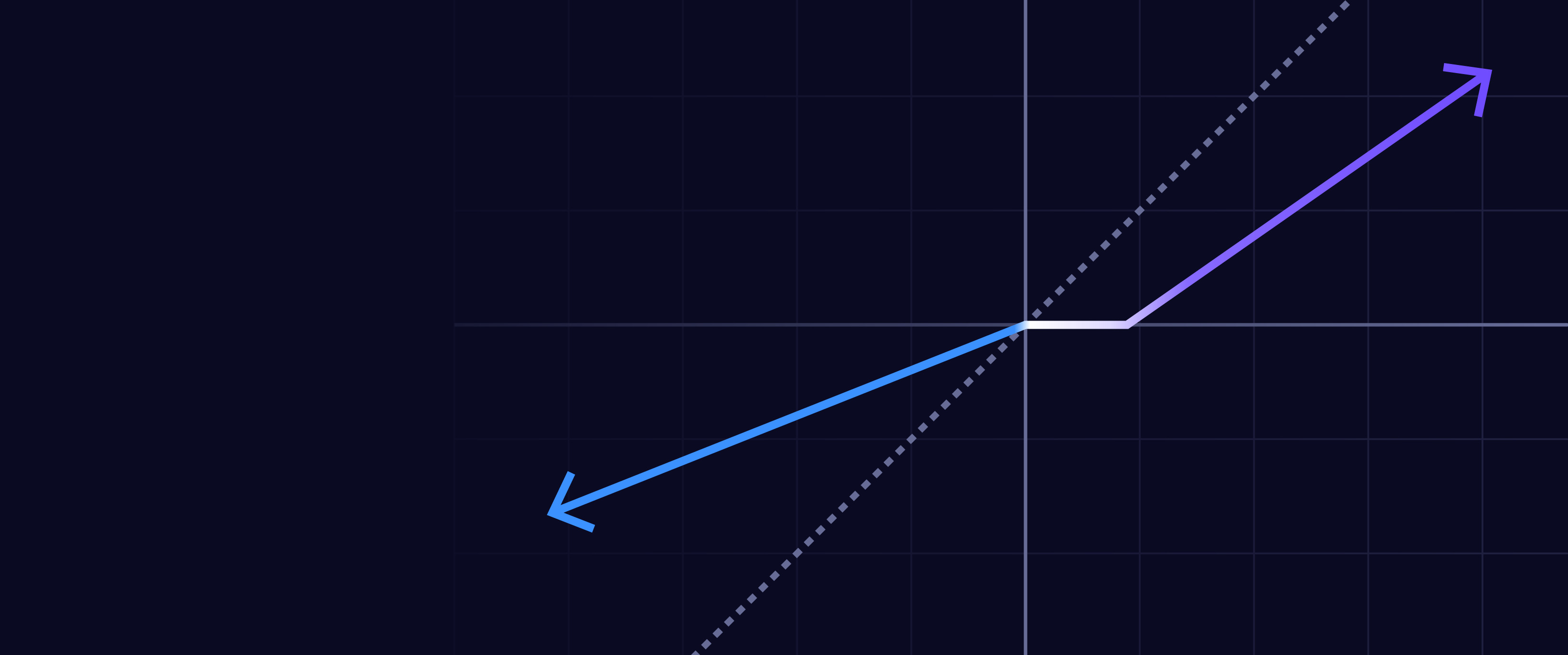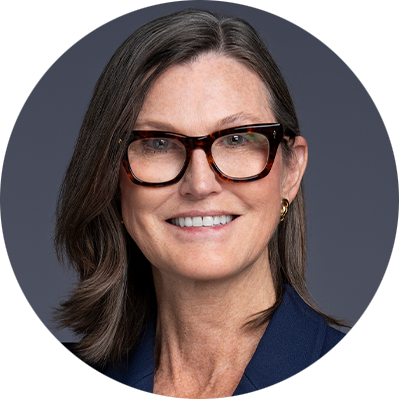Broad-based global equity indexes[1] depreciated in the third quarter as mixed economic signals obfuscated the outlook. Contrary to consensus expectations, ARK expects an economic landing somewhat harder than soft, though not as severe as that associated with the Great Financial Crisis. Indeed, the US economy seems to have been in a rolling recession, as cyclically sensitive indicators like housing, autos, and inventories have been under recession-like pressure for nearly two years. In our view, growth in ARK’s Five Innovation Platforms could play an outsized role in pulling the economy out of recession and salvaging corporate margins as inflation gives way to deflation in many sectors.
Rolling recessions are sending mixed economic signals to the market.
- A lagging indicator, employment has played an oversized role in the Federal Reserve’s rate decisions. The COVID-19 pandemic led to significant labor disruptions that are resolving. For six months, the Bureau of Labor Statistics had revised down nonfarm payroll statistics and, while the most recent report broke that streak, the labor market is likely weaker than government reports suggest. The last time revisions to nonfarm payrolls were down for six consecutive months in the absence of a recession was in 2007, months before the onset of the Great Financial Crisis.
- M2[2] growth has dropped at a 3.7% year-over-year rate, a level not seen since the 1930s.[3] While sequential declines seemed like a natural unwind after the COVID-related surge, continued weakness could be consistent with a recession. Moreover, because rising mortgage rates have trapped homeowners in their homes, the velocity of money could be in the process of slowing down, adding to the drag from M2’s decline. More rate hikes could exacerbate this fragile situation, encouraging investors to continue moving deposits to higher yielding money market funds.
- Strongly correlated with Real Gross Domestic Product (GDP), the U.S. Leading Economic Index (LEI) has been in negative territory for 14 consecutive months and now is down 7.6% on a year-over-year basis.[4] Real Gross Domestic Income (GDI)—which should equal GDP over time—is limping along at 0.2% growth on a year-over-year basis, well below the 2.4% delivered by real GDP.[5] During the last two quarters, the near record divergence in real growth rates between GDP and GDI has been begging the question about future revisions: will GDI be revised up or GDP down. Our view is the latter.
- In tandem with depressed consumer sentiment as measured by the University of Michigan,[6] the personal saving rate has dropped from 9.3% pre-COVID to 3.9%,[7] pointing to weaker consumption growth if, as we expect, the unemployment rate continues to increase. Adding to those concerns, the third largest category of non-housing debt, credit card balances have surpassed a record high level at $1 trillion.[8] Because interest rates on credit cards have almost doubled to 20-21% during the past ten years,[9] the burden of credit card debt has intensified. Adding to the pressures are the resumption of student loan payments and elevated gas prices.
- China may be exporting more deflation than many experts anticipated. Despite a 14% depreciation in the yuan against the dollar,[10] China’s Producer Price Index (PPI) has decreased by 3%,[11] signaling underlying deflation approaching 17%. In efforts to stabilize its currency, China seems to be selling US dollar reserves to buy yuan,[12] which would be the equivalent of tightening its monetary policy. Concurrently, the U.S. Federal Reserve’s substantial interest rate hikes have increased the risk of worldwide deflation.
- Despite other countries’ attempts to stabilize their currencies by selling dollars, the U.S. Fed Trade Weighted Dollar Index is trending higher, somewhat surprising in the face of higher government and trade deficits but in keeping with its role as a haven during times of economic uncertainty. Should a struggling Eurozone slide into recession, the USD could strengthen further, posing more challenges to US multinationals and emerging markets.
- The auto industry faced significant challenges during the COVID-19 pandemic and, while the sector did witness a V-shaped recovery, current sales annualizing in the 15 million unit[13] range are more consistent with recessions. In a notable development, to increase affordability in a sluggish consumer environment, Tesla has slashed the price of its Model Y by 27% year-over-year. Interestingly, in the early days of the pandemic, autos accounted for roughly one third of the inflation spike, a trend that Tesla seems to be reversing.
Although recent comments from U.S. Federal Reserve Chairman Powell tempered investor outlooks, we interpreted positively his comment that rates are restrictive. The Federal Funds Target Rate has surged 22-fold in the last 18 months, a faster pace than all previous tightening cycles—including the one in 1980-1981 that crushed inflation—creating significant strains at regional banking and in commercial real estate. According to renowned economist, Milton Friedman, monetary policy works with “long and variable lags” that last 12-18 months, suggesting that the full impact of the Fed’s unprecedented tightening has yet to be felt.
While the Fed is determined to squelch inflation by increasing interest rates, the bond market has been signaling that it could be making a major mistake. From March 2021 to July 2023, the yield curve[14] flattened by 267 basis points, inverting from +159 to -108 basis points,[15] the worst inversion since the early 1980s when the Fed was fighting entrenched double-digit inflation. Since July 2023, the yield curve has entered a bear steepening, with long term rates increasing relative to short term rates, lowering the inversion to -30 basis points.[16] This dynamic suggests that both real growth and inflation could surprise on the low side of expectations. In ARK’s view, the Fed is making decisions based on lagging indicators—employment and headline inflation—and ignoring leading indicators that are telegraphing recession and/or price deflation.
The Federal Reserve began increasing interest rates when the year-over-year Consumer Price Index (CPI)—a lagging economic indicator—reached 8.5% on a year-over-year basis in March 2022. Shortly thereafter, an inflationary surge influenced by geopolitical pressures and inventory hoarding peaked at 9.1% year-over-year. Since then, CPI inflation has dropped to 3.7%,[17] thanks to various deflationary forces––good, bad, and cyclical.
Innovation is a potential source of good deflation, as learning curves can cut costs and increase productivity. Yet, we believe many companies have catered to short-term-oriented, risk-averse shareholders, satisfying their demands for profits/dividends “now”. On balance, they have leveraged their balance sheets to buy back stock, bolster earnings, and increase dividends. In so doing, many have curtailed investments and could be ill-prepared for the potential disintermediation associated with disruptive innovation. Saddled with aging products and services, they could be forced to cut prices to clear unwanted inventories and service debt, causing bad deflation.
If we are correct in our assessment that growth, inflation, or both will surprise on the low side of expectations, scarce double-digit growth opportunities should be rewarded accordingly. The adoption of new technologies typically accelerates during tumultuous times as concerned businesses and consumers change their behavior much more rapidly than otherwise would be the case. As a result, stocks of innovation-oriented companies have historically performed better and emerge as new market leaders toward the end of a bear market. We believe the coronavirus crisis and Russia’s invasion of Ukraine have transformed the world significantly and permanently, suggesting that many innovation-driven strategies and stocks could be productive holdings during the next five to ten years. Provocative proofs of concept from artificial intelligence (AI) generally and ChatGPT specifically are a case in point. Increased demand for AI hardware is pointing toward a significant acceleration in software revenue growth. As companies develop AI-powered products and services, ARK estimates that software may generate up to $21 of revenue for every dollar spent on AI hardware over its useful life, roughly four years. In what could be “winner take most” opportunities, we believe companies with large pools of proprietary data and broad-based distribution should be best positioned to capitalize on AI use cases and reap the potentially dramatic productivity gains associated with generative AI.
In our view, the wall of worry bodes well for equities in the innovation space. The strongest bull markets climb walls of worry, a fact that those making comparisons to the tech and telecom bubble seem to forget. No wall of worry existed or tested the equity market in 1999. This time around, the wall of worry has scaled to enormous heights.
During the third quarter of 2023, ARK’s actively managed ETFs underperformed relative to the broad-based global equity indexes; indexed ETFs had mixed performance, one outperformed and one underperformed.[18]
The ARK Autonomous Technology and Robotics ETF (ARKQ) underperformed broad-based global equity indexes during the quarter. Among the top detractors from ARKQ’s performance were Iridium Communications Inc (IRDM) and 3D Systems Corp (DDD). Shares of Iridium traded down after the company reported its second-quarter results. While optimistic about Iridium’s capabilities for beyond-line-of-site drone applications, management does not expect the first activations of its direct-to-device offering to ramp until 2024. Iridium Communications provides satellite-based voice and data communication products and services to businesses and government agencies globally. Shares of 3D Systems continued to trade down after the company announced its intention to acquire Stratasys. In addition, one of its top customers, Align Technology, acquired Cubicure, a private company that could compete with 3D Systems in developing 3D printing solutions for polymer additive manufacturing. Finally, in September, the company announced that CFO Michael Turner will step down. Andrew Johnson, Executive Vice President, Chief Corporate Development Officer, and Chief Legal Officer will serve as interim CFO.
Among the top contributors were Archer Aviation Inc (ACHR) and AeroVironment Inc (AVAV). Archer Aviation shares rallied after the company announced new contracts with the US military, highlighting Archer’s innovative eVTOL (electric Vertical Take-Off and Landing) aircraft. Archer also bolstered its balance sheet with a $215 million funding round from key partners — Stellantis, Boeing, and United Airlines — paving the way for FAA certification and commercial operations in 2025. Shares of AeroVironment rallied as the company reported its first-quarter earnings, delivering ~40% revenue growth on a year over year basis and raising fiscal 2024 revenue and net income guidance. AeroVironment designs and manufactures unmanned aerial vehicles.
The ARK Next Generation Internet ETF (ARKW) underperformed broad-based global equity indexes during the quarter. Among the top detractors from ARKW’s performance were Block Inc (SQ) and Unity Software Inc (U). Block shares fell after the company disclosed that the CEO of Square, Alyssa Henry, will depart on October 2nd and that Jack Dorsey will step in to manage the seller ecosystem division. We believe Square is positioned uniquely to facilitate increased collaboration between its seller ecosystem and its Cash App consumer platform. Shares of Unity traded down after the company introduced a new Unity Runtime Fee that charges game developers fees per installation on games that meet various revenue thresholds. The pricing changes were met with significant developer and social media backlash, forcing the company to propose a more generous and acceptable alternative. Under the new structure, Unity will not charge a Runtime Fee for Unity Personal users or any game generating less than $1 million per year. Moreover, Unity Pro or Enterprise users will have the option to calculate their Runtime Fee based on either a 2.5% revenue share or the number of new people playing their games. Because Epic Games requires Unreal Engine users to pay 5% of their revenue to the platform, Unity’s new pricing structure should help its monetization efforts.
Among the top contributors were Coinbase Global Inc (COIN) and ROKU Inc (ROKU). Shares of Coinbase and other crypto-related stocks rallied after a landmark U.S. District Court ruled that neither Ripple’s XRP token sales on public exchanges nor the XRP token are “securities,” paving the way for Coinbase to re-list the XRP token. The ruling also supports the argument that Coinbase is making in its own case against the SEC. Shares of Roku traded up after the company released its second-quarter results. Roku’s platform revenue grew 11% year-over-year, as active accounts increased 16% to 73.5 million and streaming hours jumped 21% to 25.1 billion. Roku’s second-quarter results reaffirm our conviction in its potential to revolutionize digital streaming and displace linear TV incumbents. Moreover, the company also announced a partnership with Shopify to introduce shoppable ads to its users.
The ARK Genomic Revolution ETF (ARKG) underperformed broad-based global equity indexes during the quarter. Among the top detractors from ARKG’s performance were Schrodinger Inc (SDGR) and Exact Sciences Corp (EXAS). Shares of Schrodinger fell after the company reported second-quarter earnings, including a significant decline in drug discovery revenues. That said, the company boosted its expectations for full-year software revenue growth to 12-18% and announced the end of its research and development collaboration with Zai Lab, giving Schrodinger full ownership of the oncology program. In addition, Schrodinger appointed Dr. Margaret Dugan, a medical oncologist and hematologist, as Chief Medical Officer. Schrodinger develops software and computation platforms for drug discovery and material sciences. Shares of Exact Sciences declined after the company reported second quarter revenue and core revenue growth rates of 19% and 24% on a year over year basis, respectively. Core revenue excludes COVID testing revenue. Exact Sciences also acquired Resolution Bioscience from Agilent for its high-quality liquid therapy selection platform, a complement to its OncoExTra test.
Among the top contributors were Ionis Pharmaceutical (IONS) and Repare Therapeutics (RPTX). Ionis Pharmaceuticals, a biotechnology firm specializing in RNA-targeted therapeutics, unveiled its Phase 3 NEURO-TTRansform study results for ATTR Polyneuropathy (ATTRv-PN) showing sustained improvements over 85 weeks. Additionally, Ionis’s Phase 3 data for Olezarsen met its primary endpoint, significantly lowering triglyceride levels in patients with familial chylomicronemia syndrome. The company also broadened its collaboration with AstraZeneca, partnered with Roche on new RNA-targeted treatments, and joined forces with Novartis to work on medications for Lp(a)-driven cardiovascular disease. Shares of Repare Therapeutics rallied after the company reported strong second-quarter results, highlighting that it has sufficient cash reserves to fund its planned operations into 2026. Repare utilizes its proprietary, genome-wide, CRISPR-enabled SNIPRx platform to discover and develop cancer therapies.
The ARK Fintech Innovation ETF (ARKF) underperformed broad-based global equity indexes during the quarter. Among the top detractors from ARKF’s performance were Block Inc (SQ), for reasons discussed above, and Adyen (ADYEN NV). Shares of Adyen depreciated after the company reported first-half earnings that missed consensus estimates of total processed volume, net revenue, and EBITDA (earnings before interest, taxes, depreciation and amortization). Management noted increased price competition and weakness across North American enterprises as customers shift their focus from growth to cost optimization. Confident that Adyen offers the most robust global payments technology at the lowest total cost of ownership relative to its competitors, management will not compete on pricing and will continue to invest in headcount and research and development (R&D) to drive higher growth and margins. Adyen is a global payments facilitator providing back-end financial infrastructure for merchants across many verticals.
Among the top contributors were Coinbase Global Inc (COIN), for reasons discussed above, and DraftKings Inc (DKNG). Shares of DraftKings appreciated after a Bank of America analyst upgraded the stock, noting a faster than expected ramp in the number of states legalizing on-line betting states and higher take rates from parlays and other mix shifts.
The ARK Space Exploration & Innovation ETF (ARKX) underperformed broad-based global equity indexes during the quarter. Among the top detractors from ARKX’s performance were Iridium Communications (IRDM), for reasons discussed above, and Joby Aviation Inc (JOBY). Shares of Joby Aviation declined after JP Morgan downgraded the stock, citing its higher valuation relative to peers as well as uncertainty as to when the FAA will approve the commercialization of eVTOLs. Highlighted during the second-quarter earnings results, Joby’s first production eVTOL prototype began flight testing and the FAA has accepted more than two-thirds of its certification plans. Finally, the company delivered its first eVTOL to Edwards Air Force Base approximately six months ahead of the expected delivery date in 2024.
Among the top contributors were AeroVironment Inc (AVAV) and Archer Aviation Inc (ACHR), for reasons discussed above.
Invested in the highest conviction names in the Funds discussed above, the ARK Innovation ETF (ARKK) underperformed broad-based global equity indexes during the quarter. Among the top detractors from ARKK’s performance were Unity Software Inc (U) and Block Inc (SQ), for reasons discussed above.
Among the top contributors were Roku Inc (ROKU) and DraftKings Inc (DKNG), for reasons discussed above.
Among ARK’s self-indexed ETFs, the ARK Israel Innovation Technology ETF (IZRL) outperformed, and The 3D Printing ETF (PRNT) underperformed the broad-based global equity indexes.[19]
Camtek Ltd (CAMT) was the largest contributor to IZRL’s performance. Shares of Camtek appreciated after the company announced that orders for ~100 systems for High Bandwidth Memory (HBM) manufacturers and Chiplet applications since July 2023. The company also announced its acquisition of FormFactor’s FRT Metrology unit. Camtek is a developer and manufacturer of high-end inspection and metrology equipment for the semiconductor industry. Nano-X Imaging Ltd (NNOX) was the largest detractor from IZRL’s performance after it announced a $30 million secondary offering. Nano-X Imaging is focused on applying its proprietary medical imaging technology to make diagnostic medicine more accessible and affordable.
3D Systems Corp (DDD) was the largest detractor from PRNT’s performance, for reasons discussed above. Markforged Holding Corp (MKFG) was the largest contributor to PRNT’s performance. Shares of Markforged rose on little company-specific news. The company announced that CFO Mark Schwartz will be stepping down and that Assaf Zipori, Senior Vice President of Strategy and Corporate Development, will serve as interim CFO. It also reported mixed Q2 earnings but the stock’s uptrend could be linked to recent merger and acquisition activity in the 3D printing industry among Stratasys, Desktop Metal, Nano Dimension, and 3D Systems. Markforged is a 3D printing company specializing in continuous carbon fiber 3D printing.
As measured by the S&P 500 and MSCI World.
M2 is a measure of the U.S. money stock that includes M1 (currency and coins held by the non-bank public, checkable deposits, and travelers’ checks) plus savings deposits (including money market deposit accounts), small time deposits under $100,000, and shares in retail money market mutual funds.
U.S. Federal Reserve Economic Data from January 1960 to August 2023. M2 prior to 1960 is calculated by adding Currency Held By The Public, Deposits Adjusted Commercial Banks, Bank Vault Cash, Monetary Gold Stock, and Deposits At Nonbank Thrift Institutions.
The Conference Board. Data as of August 2023.
U.S. Federal Reserve Economic Data as of April 2023. GDP is the total market value of all finished goods and services produced within a country’s border in a specific time period, typically a year. GDI is a measure of the total income generated by a country’s economy within a specific time period, typically a year.
As of September 2023, measured by the University of Michigan.
U.S. Federal Reserve Economic Data. Saving rate was 9.3% as of February 2020, and 3.9% as of August 2023.
U.S. Federal Reserve Economic Data as of September 13, 2023.
U.S. Federal Reserve Economic Data as of August 2023.
Bloomberg. CNY/USD exchange rate was 6.3092 on February 28, 2022, and 7.298 on September 28, 2023. The reciprocal rate is used to calculate the percentage change of yuan relative to dollar.
National Bureau of Statistics of China. Data as of August 31, 2023.
Macrobond data. Since their post-COVID peak in April 2021, total China holdings of U.S. Treasuries has decreased from $1.1 trillion to $0.8 trillion, a 26% decrease.
WARD’s Automotive Group. Data as of September 30, 2023.
As measured by the difference between yields on the 10-year Treasury bond and the 2-year Treasury note.
An “inversion” means that the long-term Treasury yield is lower than the short-term Treasury yield. The yield difference was +159 basis points on March 29, 2021, and -108 basis points on July 3, 2023. One basis point is equal to 1/100 of a percentage point, or 0.01%.
The yield different was -30 basis points on October 6, 2023.
U.S. Bureau of Labor Statistics. Data as of August 31, 2023.
Broad-based global equity indexes are defined as the S&P 500 Index and the MSCI World Index.
IZRL performed in-line with its benchmark, ARK Israel Innovation Index. PRNT performed in-line with its benchmark, The Total 3-D Printing Index.
ARK’s statements are not an endorsement of any company or a recommendation to buy, sell or hold any security. ARK and its clients as well as its related persons may (but do not necessarily) have financial interests in securities or issuers that are discussed. Certain of the statements contained may be statements of future expectations and other forward-looking statements that are based on ARK’s current views and assumptions and involve known and unknown risks and uncertainties that could cause actual results, performance, or events to differ materially from those expressed or implied in such statements.
Explore ARK Funds
Featured Funds:

ARK Trade Notifications
ARK offers fully transparent Exchange Traded Funds (“ETFs”) and provides investors with trade information for all actively managed ETFs.








